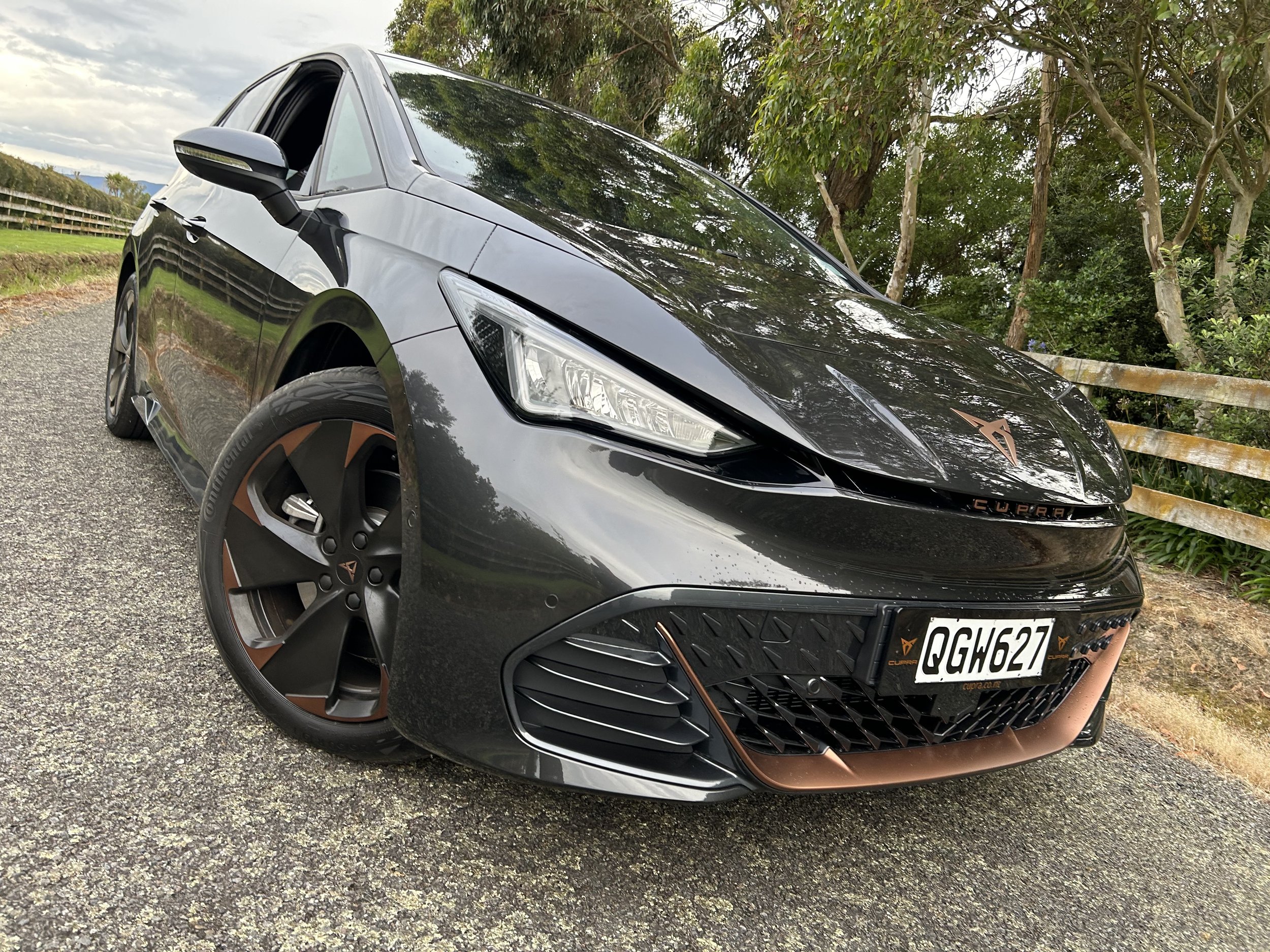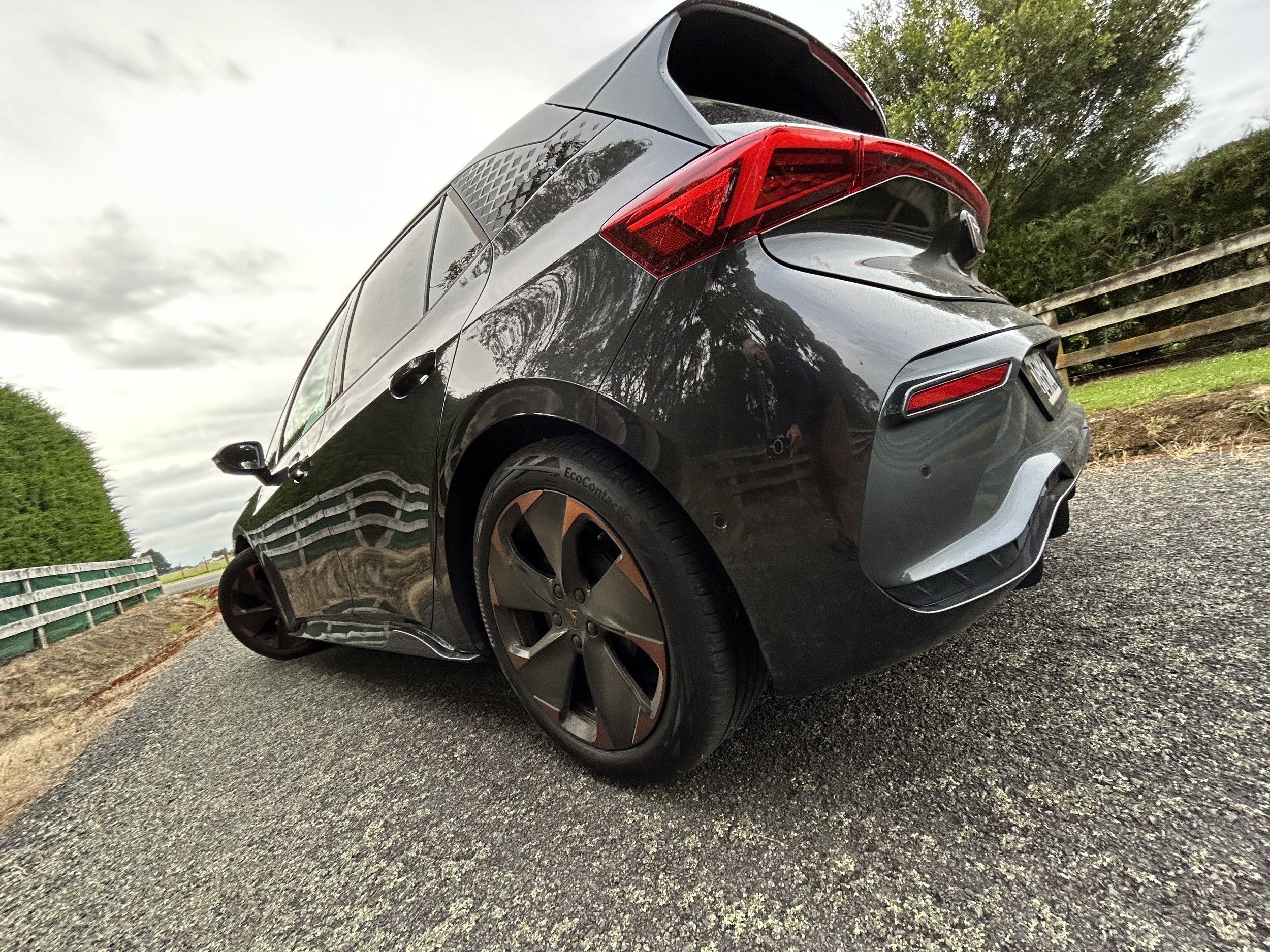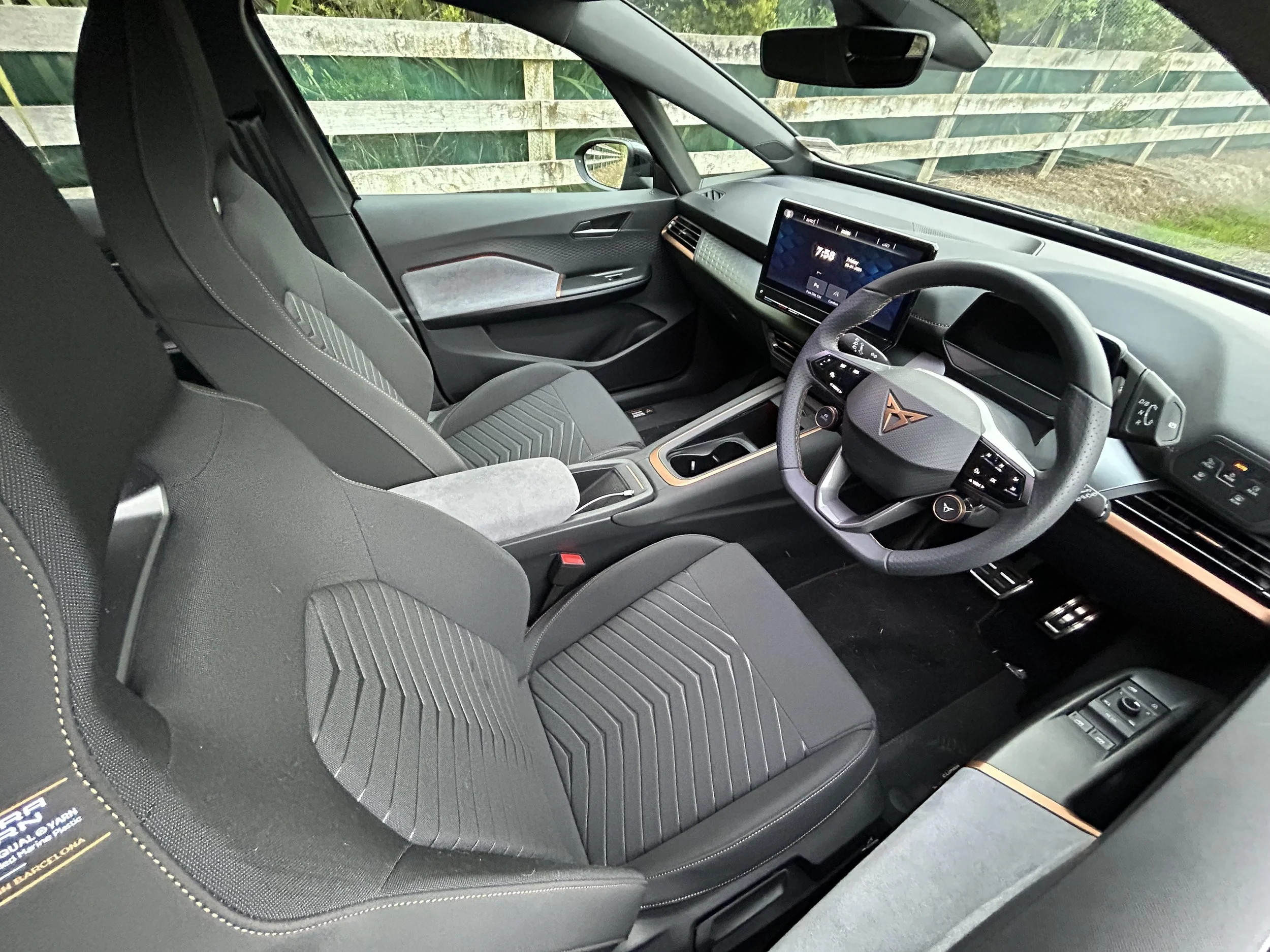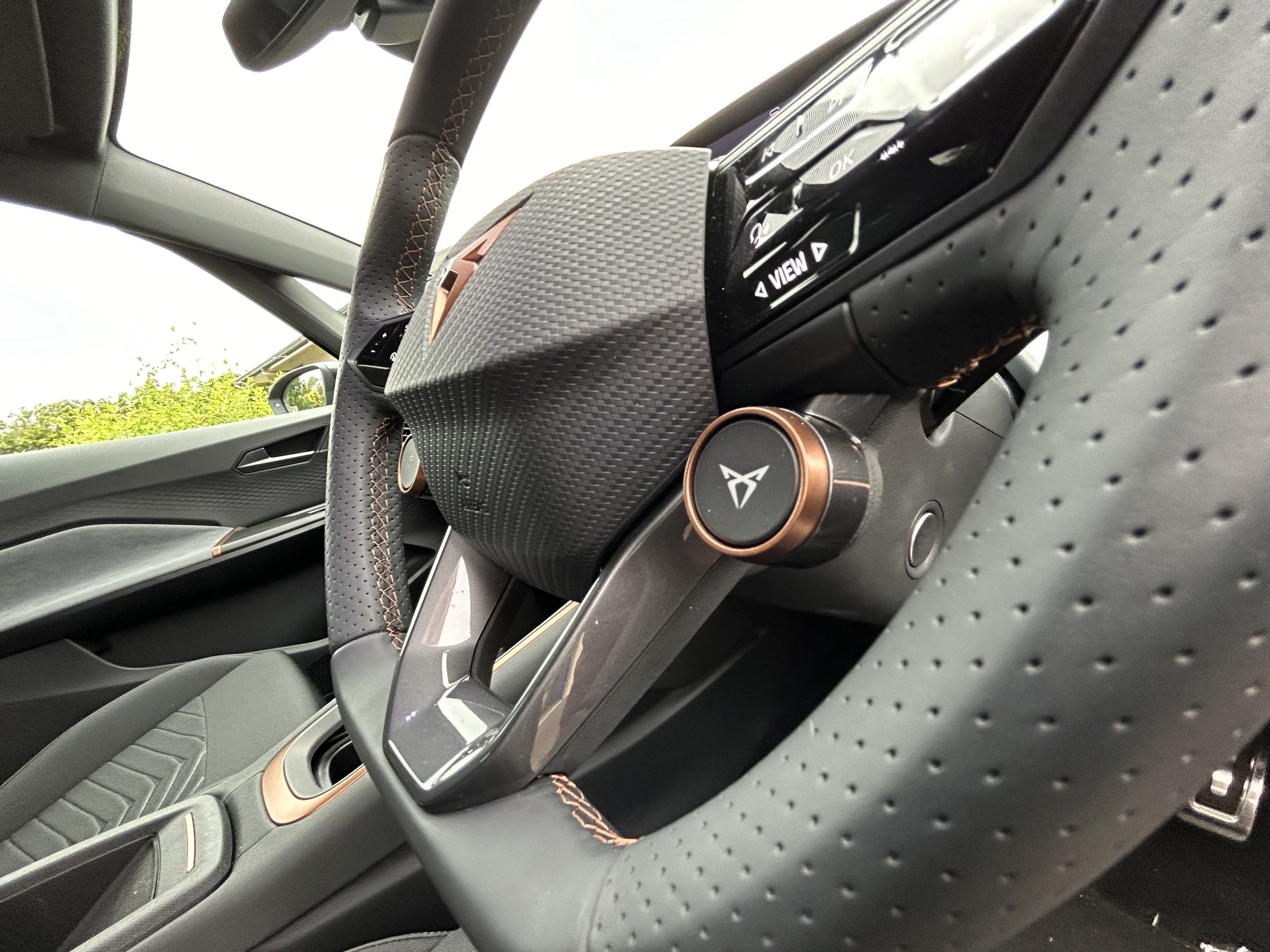Cupra Born roadtest review: One from the heart
/Some electrics are for geeks. This one? For car lovers.
Price: $74,900
Powertrain: Single electric motor, rear drive, 77kWh lithium ion battery, maximum power 170kW, maximum torque 310Nm.
How big: 4322mm long, 1809mm wide, 1540mm high, 2766mm wheelbase.
We like: Has a genuinely fun feel; looks good; decent value.
Not so much: No over the air updates.
GROWING consensus from some quarters of the automotive industry is that range and astounding 0-100kmh stomp are not enough to sell an electric.
What’s equally, if not more important, is to deliver a package engineered so that straight-line stonk is matched with agility, tactility and sensual appeal.
Okay, by ‘some quarters’ I really mean European brands. Of those, one that has taken an early lead is a make you might not give a lot of consideration to.
Cupra? Amazing how some people STILL don’t know about it. This is the Spanish element of the Volkswagen Group; derived out of Seat, but now a standalone, to point where the parent has pulled out.
From now on, Cupra’s ‘end of Empires’ tribal badge is the sole sight in local showrooms.
Volkswagen’s commitment to electric has already jolted Cupra. The Born is a compact hatchback-looking crossover built upon the Group’s battery-bespoke platform, called MEB.
All MEB cars use the same VW-supplied ‘toolkit’. Yet though it shares a battery, motor and much of the software with the rear-drive VW ID/4/ID.5, Skoda Enyaq and Audi Q4/Q5, Born is a bit different. DNA linkage is actually closer to a VW battery car set to show here at year-end, the ID.3.
Conformity to general ID proposition of offering European design with decent range and performance occurs with Born. Yet there’s a discernable flavour enhancement to the driving.
Cupra’s remit is simple. It’s the make that puts a snazzier, snappier Spanish twist on the sensible pants German-engineered foundations from Volkswagen.
All its petrol cars are designed and engineered to provision more emotional flair and fizz than might come when the same essential ingredients site behind the parent, Audi and Skoda badges.
That’s gone okay for the fossil-fuelled products. The Formentor, in particular, stands out as being cooler, faster and better value than the Golf, from which you’d barely guess it derives, so radical is the styling change.
But electric is a different ball game. Born’s proposal as the first electric hot hatch made it one of a kind when the car was signed up for New Zealand play, more than a year ago. By the time it arrived, though, MG had brought in a car that ostensibly gave even more, for less: the MG4 XPower.
With a heap more outright grunt, channelling via two motors - for a-wheel-drive - and a cheaper price, some might think the Sino-Brit threatened to leave the Spanish flier zapped before it even got a chance to prove itself?
Time with both cars recently left me firmly of the opinion that enthusiasts buying for best all-round fun will likely find Born to be a better bet.
Sure, the MG is far more exhilarating for step-off sizzle. If you are mind that all that is required to impress is a neck-jolting, internal organ-shifting stomp from a standing start, it’s the one. The biggest blast for the lowest budget out there.
But on roads that I keep aside for hot hatch driving, China’s cheapest hottie seemed an alarmingly one-dimensional proportion. Engineering for warp speed seemed less competently matched in other area. It felt too raw, too un-developed, too much in need of a call to the likes of Recaro, Brembo and Sachs.
Born is a total antithesis. From get-go (go, go), it communicates as a car not just with decent pep but also one of high engineering pedigree. While not quite the electric equivalent of a Golf GTi, it nonetheless runs far more closely to that ethos.
You get the sense lessons learned from decades refining those petrol products have been crucial to informing this first electric exercise.
The best element with Born is that it’s among relatively few electrics that genuinely doesn’t isolate its driver.
As much as battery cars can bring out more precise aptitude from driving assists, it seems really hard for brands to engender sense of being ‘one-ness’ with what they are doing.
There are many reasons for this, one being weight. Electrics are heavy and Born is no exception - at nearly two tonnes it weighs at least a third more than the Cupra Leon that it most closely resembles in size, and most of the additional bulk is accounted for by the battery.
Born doesn’t make entirely light of that burden - as reflected by the 0-100kmh time of seven seconds - yet it seems less encumbered by the unavoidables of the electric genre than many, to point it more successfully bridge the gap between it and what we’ve always known before.
Exercising it on a decent country road is a fast-track to discovering how well it delivers dynamic dexterity, good chassis feel, decent grip and strong, confident braking. But the most enjoyable part of that experience is something else. The emotional connect. It is the most soulful electric I’ve so far experienced.
Electric car 101 now is to put the battery as it is here; low-slung between the wheel sets. With exception of the ‘quattro’ Audis, all VW Group models here are rear-drive, with a motor at the back.
I’m of an age who learned to drive in rear-wheel-drive, then had to adapt to every car afterward being front-drive, so going to a new product that pushes rather than pulls is fine and dandy. All the moreso given our fun car until recently was an original MX5 (I’m not completely off those; the road one has gone, but the race car remains).
I wouldn’t say that the Born will have Mazda’s roadster bothered on a winding road, yet that it has front wheels left to do the steering while power comes from the rear is definitely a good thing for both. And despite it being a bulky thing, having battery under the car for lower centre of gravity can used to advantage, too; the car feels balanced but, moreover, it’s also inherently stable.
True playfulness will have to await time when batteries are much lighter, but in current state it is a nippy and involving car, with ability even to lift the inside rear if you run it hard enough, and with drive programming to the sportiest, Cupra, setting. That this make has given it good, Michelin Pilot tyres, speaks oodles about their credo.
Performance-wise, there’s a bespoke Cupra button on the lower right side part of the steering wheel. Using this setting unleashes every available ohm; this designed for situations when assertive overtaking is asked for. In reality, it’s an on-demand set to used so often to wear out the activation.
Acceleration up to 100kmh or so is suitably effortless in that electric way, anyway. It will also keep moving assertively beyond that speed, but while the point at which it tails off significantly is one that most would surely not dare to find on a public road, it’s not a supercar. Top speed is south of 200kmh.
Still, come the day when electrics are allowed on NZ race tracks, it could be a great toy for a road car play day. Of all the MEB cars here, it’s the one that feels most like a conventional mid-size hatchback.
The performance ideal seems to influence every facet, save the regenerative braking. It would have nice for it to have adjustable regenerative effect as per the Enyaq and Audi, which have steering wheel paddles. In the Cupra, though, it’s the straight-laced VW ID type, with just D or the more assertive B mode.
Just the look of the Born is enough to sell it to those wondering about the fun side. ID.3 could well be here by year-end (VW NZ was awaiting a big mid-life update) and Cupra won’t be counting down the days, as they are fundamentally similar in design.
In isolation, the Born has a snappy air to it. The car’s sharp lines are a good touch but what sells here are the finishing touches: A particularly eye-catching alloy wheel design and, in this instance, a Quasar Grey paint hue that worked exceptionally well with the type trademark bronze trimmings.
Though overall the interior is to ID format, Cupra has been allowed to enhance it, so with Born you get more bronze and some nice cloth treatments, not least to the front seats, which are more heavily bolstered than in an ID car and really comfortable. Achieving a good driving position is easily possible. For one, the chairs can also be set really low, as per you can in a GTi car.
Like a current ID models, this one has the much-maligned VW infotainment system whose lack of backlighting for the volume and heating controls, plus the multi-purposed window controls, are ‘user experience’ irritations the Group plans to fix.
Also set to be addressed later this year is the rear seat, which in early delivery cars such as this shapes to accommodate two passengers, making it pure four seater. The current format doesn’t bother me, but I guess it might turn off family buyers, hence why a bench type is coming. But on that scale, it’s a rather compact car; as a tall drier, I had the seat set back and low and there wasn’t much room behind it.
Connectivity is the next big thing in onboard tech, but online services have yet to sorted for MEB product, which is a pity because Cupra in Europe has apps to enhance the individualism.
I know it’s a faff to set things up, but connectivity is important with an electric car. You might, as a for instance, want to control charging times to only draw power in off-peak electricity periods or ‘pre-condition’ the car so the battery and cabin and heated seats and steering wheel are up to temperature before you unplug and set off.
On quirk, specific to Cupra, is that you either have the air-con on or off. In the Skoda you can run the fan and have some degree of temperature control but leave the air-con switched off to preserve range.
Speaking of. Just like internal combustion cars some EVs are more efficient than others. Mental arithmetic is all part of EV ownership and figuring out how far a car will actually go (as opposed to the manufacturer’s claimed range) is a case of multiplying the battery size by that average efficiency.
I hadn’t really gone too deeply into that, having from the outset been convinced it wouldn’t have been as efficient as the other MEBs. Not simply because it presents as being more sporty but also because … well … of the way I drove it.
So my surprise at a week of much fun delivering an average of 17kWh per 100km - so better than the ID.4 and ID.5, right on part with Enyaq - was great. Not least because it had been put on the same roads in which the MG4 XPower became a very hungry thing indeed. Of course, that WLTP-cited optimal range of 511 kilometres needs to be considered a might do at best.
Being such a fun electric is a point of difference in the battery-pure arena that the Cupra Born deserves to play to advantage.
Whether it will convince those who prefer their hot hatch served with high octane is a tougher question. At the moment, you’d have to agree that whatever this car can do, a top-drawer old school petrol-fed provision could do even better.
Yet, that’s just how it goes at the moment. We are at a point where technology convergence has yet to occur. They are, ultimately, two very different experiences and will likely remain so until the car industry works out how to develop an electric with the same kind of power to weight.
However, given how fast electric car development is going, that’s surely not an ‘if’ but a ‘when’.
As is, the Born stands as an electric car that non-EV folk will want to talk about with enthusiasm.






















